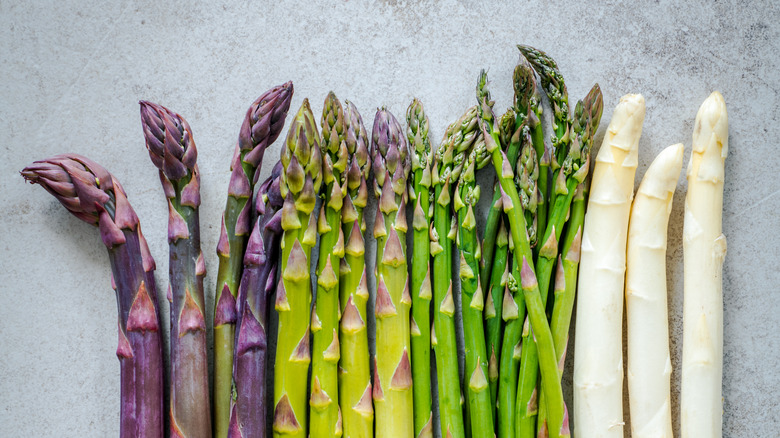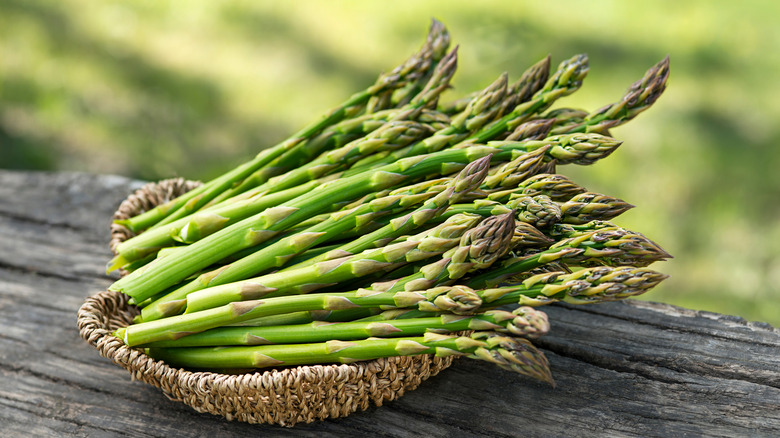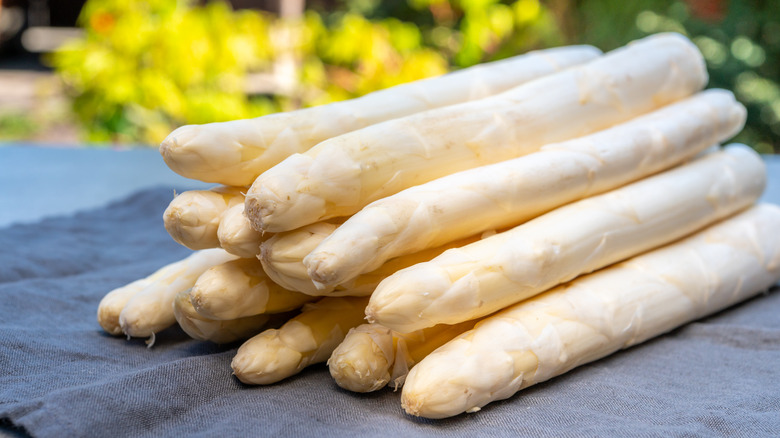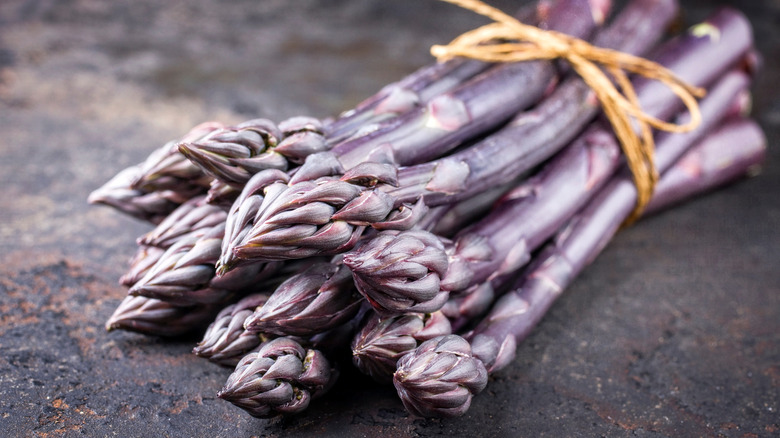The 3 Colors Of Asparagus, Explained
It's an ideal veggie side dish to a meaty main, pairs perfectly with hollandaise sauce at brunch, and comes in the shape of spears – you guessed it, it's asparagus! Not only is it delicious on its own, but you can do a lot with it – from grilling, roasting, and blanching, to even pureeing it into a creamy soup or shaving into salads. When you initially think of asparagus, the typical image of a bright green slender stalk comes to mind. However, asparagus comes in many varieties that range in color, width, and flavor.
The asparagaceae family, which includes asparagus, has many other surprising family members such as the agave and yucca plants (via Britannica). In fact, the U.S. Department of Agriculture (USDA) states that asparagus is also related to the Liliaceae family, which includes onions, leeks, and garlic. This low-calorie, nutrient-dense vegetable is known for its abundance of antioxidants, and its aid in digestion and blood pressure (via Healthline). And believe it or not, the strange smell that asparagus causes your urine to produce is actually unique to it. Cleveland Clinic reports that aspargusic acid is present in asparagus only, which gets broken down into sulfur when digested, and evaporates immediately when using the bathroom.
Available in most grocery stores, this nutritious veggie is abundant enough to cook however you please and incorporate into your diet daily. Here are the different colors of asparagus and the reason behind their appearance.
Green asparagus
Green asparagus is the obvious one that most everyone envisions. Seeing asparagus in a color other than green may come as a surprise because you can almost always find this variety at most grocery stores. According to MasterClass, green asparagus has skinnier stalks than the other colors. The reason they're green is due to the chlorophyll within the vegetable's cells that becomes present during photosynthesis. The USDA states that chlorophyll is necessary in order for plants to create energy from the sun, and chlorophyll is actually activated by the sun. Plants that aren't exposed to sunlight can't develop a green hue due to the lack of chlorophyll being activated. This shows that color is a big indicator of how each variety is grown. In fact, the "Martha Washington" variety of asparagus is the most popular type of green asparagus.
Green asparagus has a bit more of a grassy flavor. Because the spears are thinner than other varieties, they're not as ideal for grilling. According to The Spruce Eats, the best way to utilize green asparagus is by steaming with butter, marinating in a vinaigrette dressing, or blanching. For an appropriate celebration of the asparagus season, which is Spring, add a squeeze of lemon to bring out its freshest flavors.
White asparagus
White asparagus' lack of color is a true testament to how it's grown. It gets its unique appearance from being grown in the dark. MasterClass states that this method prevents photosynthesis from occurring. In fact, The Spruce Eats says it's grown underground. Essentially what happens is farmers do one of two things: pile a hefty layer of dirt over the asparagus, or completely cover it with black plastic, all to ensure that zero sunlight hits the spears. This process is called etiolation (per The Daily Garden). Because of this, chlorophyll cannot be activated inside the vegetable, which keeps them white instead of changing colors to green.
The Spruce Eats states that white asparagus has a milder taste and typically is much thicker in width than green asparagus. It's got a tougher exterior, so peeling the stalks, especially the bottom two-thirds, is ideal in order to get it tender when cooking. In fact, roasting and grilling are the best techniques to ensure they get cooked all the way through.
According to EatingWell, white asparagus is a German delicacy that is served in celebration at festivals in April, May, and June. White asparagus is grown more abundantly in Europe but can be tricky to find in American grocery stores.
Purple asparagus
Purple asparagus has quite an interesting appearance. Believe it or not, there's a longer list than expected of green vegetables that also have purple varieties, such as cabbage, kale, Brussels sprouts, artichokes, and even peas. MasterClass states that purple asparagus gets its unique color from containing high levels of a chemical compound called anthocyanins. According to Specialty Produce, anthocyanins are strong antioxidant flavonoids that actually have major health benefits. They reduce inflammation and even have cancer-healing properties. Purple asparagus is much less fibrous than white or green asparagus, which yields a much softer, more tender texture.
With 20% more sugar in these spears, purple asparagus has a sweeter, slightly nutty flavor (per The Spruce Eats). Here's the kicker: While the asparagus may look purple, the interior is just as vibrant green as its sibling. Therefore, if you want to maintain the beautiful color, Eat Like No One Else states that a quick blanch is the way to go because the purple pigment is sensitive to heat. When exposed to heat, the color will fade and strip to its interior color, which is green.



